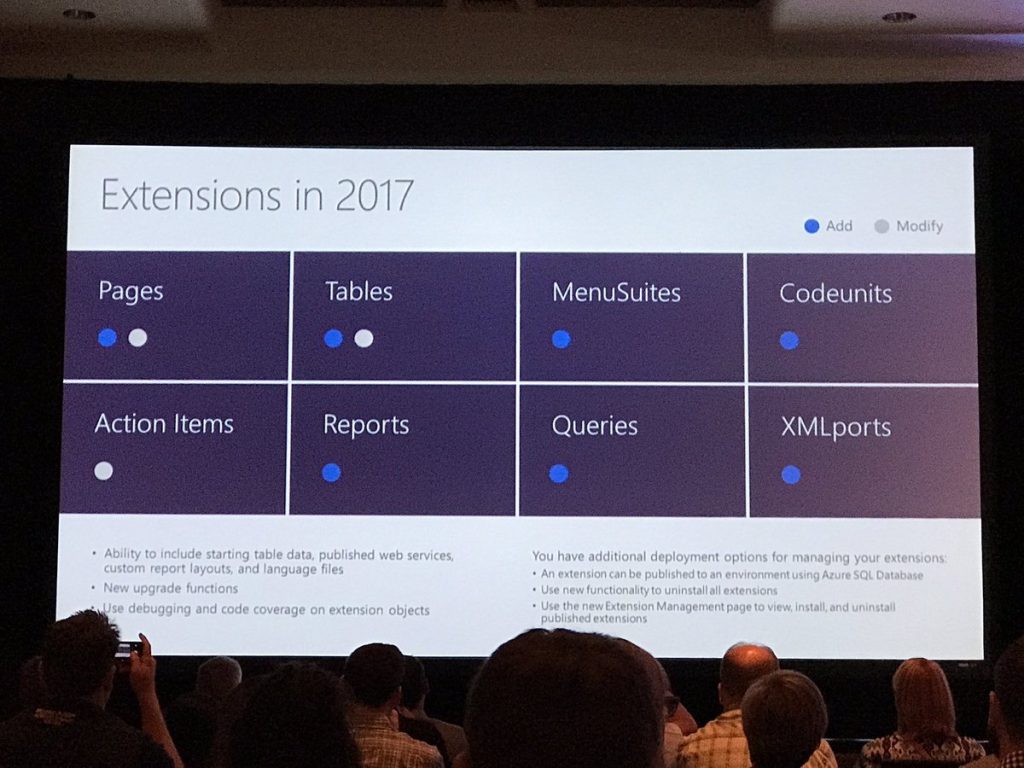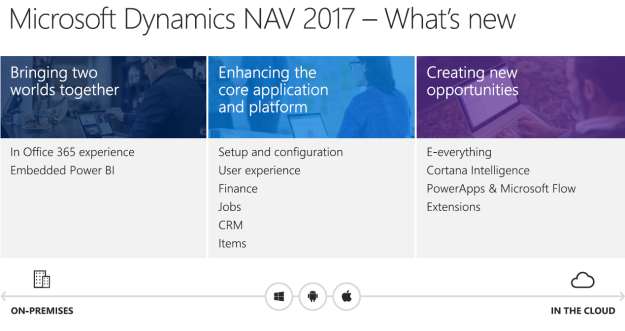October 24th sees the launch of Dynamics NAV 2017, the latest stage in Microsoft’s roadmap for the evolution of its flagship product that continues to lead the market. The company set expectations for the launch when it released initial details earlier in October at the biggest NAV event, Directions EMEA. According to the Microsoft announcement, Dynamics NAV 2017 will focus on three pillars:
- Bringing two worlds together
- Creating new opportunities
- Enhancing the core application and platform.
The two worlds in question are deeper integration with Office 365 and embedded Power BI. The new opportunities relate to further moves to cloud, plus access to Cortana Intelligence and developments in PowerApps, Flow and Extensions. And, the company has promised application improvements in areas such as Jobs, CRM, Finance and Items, as well as the core platform.
These highlights and the more detailed developments behind them promise much for Dynamics NAV users. With growing business interest in cloud and Office 365 generally, NAV users look set to take advantage of the ‘two worlds‘ and upgrade to the latest version. So, it‘s important to get familiar with Dynamics NAV 2017 and take advantage of the revenue and business opportunities that upgrades will offer.
A brave new world?
Integration with Office 365 is certain to be one of the talking points of NAV 2017. Coupled with the earlier launch of Dynamics 365, critics are asking if Microsoft is taking its focus off premise solutions like NAV in favor of SaaS models. Not according to Microsoft MVP Waldo (Eric Wauters), who believes that premise solutions are here to stay.
Office 365 capability will allow customers to review, analyze and share Dynamics NAV data with their colleagues using familiar Microsoft applications like Word, Excel and Outlook. Microsoft sees great productivity and collaboration benefits in this type of integration, which is already happening in telecommunications and other business processes.
In practical terms, new developments include the ability to invoice customers based on entries in the Outlook calendar, integration of Dynamics NAV 2017 with emails, and shared contacts between NAV and Office 365.
While commentators see Dynamics NAV and Dynamics 365 as separate products, there may be long-term opportunities for developers in both areas. The code base for both products is the same in the current release and a number of Dynamics 365 features are incorporated in Dynamics NAV 2017.
Dynamics NAV 2016 saw native integration of Power BI with NAV, giving users access to performance data for improved decision-making. The latest version sees Power BI embedded within NAV, giving users the ability to call up interactiverole-tailored reports without leaving the NAV client. This is a great boost to reporting and productivity.
Seizing new opportunities
Microsoft‘s third pillar, Creating new opportunities, is bringing machine intelligence and the cloud into the Dynamics NAV 2017 environment and giving greater credibility to Extensions.

Picture from Jatin Patel blog from Directions EMEA
Cortana‘s machine intelligence is set to improve sales and inventory forecasting. The new functionality claims to transform data into intelligent actions using an integrated advanced analytics suite. With just a few lines of C/AL code, users can interact with Azure Machine Learning and get predictions based on data stored in applications.
Extensions, which generated excitement at the NAV 2016 launch, give developers the ability to extend and customize a NAV deployment without modifying the original application objects, making upgrades much easier. MVP Waldo (Eric Wauters) commented that Dynamics NAV 2017 demonstrates that Microsoft is committed to Extensions as a very important part of the product. He added that the number of new capabilities in this latest release now make Extensions a lot more feasible.
Mark Brummel’s, Microsoft Dynamics NAV MVP view is that Extensions in Dynamcis NAV 2017 are not perfect but they have significant potential and, over time, they will affect almost every NAV implementation. He believes that the adaption will be slow at first but will rapidly increase over next three years and that means developers must start embracing them now before it is too late.
Taking applications further
Within Microsoft‘s Enhancing the core application and platform pillar, there are a number of improvements designed to improve the user experience when using Dynamics NAV 2017 applications.
One example is the update to CRM functionality. So far, Microsoft have announced a number of improvement. The wizard pages have become card pages so that they can be used in a web client. Worksheet pages have been replaced by list pages for use in browsers. The contact card default page has been simplified by designating certain controls as additional. There is now a Sales and Relationship Manager Role Centre to highlight the importance of relationships within CRM. And Microsoft is providing a new wizard to streamline set-up.
In May this year, Aleksandar Totovic, CEO, ERP Consulting stated that we need better functionality in some areas where clients are not satisfied – Service and Job Management, for example. In NAV 2017, Jobs have been significantly updated. There is a Project Manager field to identify the owner of a project and a new My Jobs list that displays job status. A new fact box shows Job Cost information. And, to simplify the structure, the Reports tab has been removed and replaced by a drop-down list under the Actions tab.
The Item card benefits from features already deployed in Dynamics 365. Inventory items, for example, have an increased number of attributes, making it easier to match a customer’s specification. Users can define specifications such as color, dimensions and manufacturing source, and filter a search by any attribute.
What the experts say
A number of MVP’s have commented on Dynamics NAV 2017 and it’s potential. Saurav Dhyani, Microsoft MVP sees the relationship between Dynamcis NAV 2017 and Dynamics 365 as productive – ‘I think anything which was there in Dynamics 365/Project Madeira, should be part of Dynamics NAV 2017.‘
Microsoft MVP Waldo (Eric Wauters), said, ‘The more I dive into Dynamics NAV 2017, the more I get stimulated to dive deeper as there are so many things I don’t know yet.‘ Commenting on his blog post, What‘s really new in Dynamica NAV 2017, he said, ‘It turned out to be a big blogpost. But that’s only because Microsoft once again did a whole lot in (just) one year.‘
Make the most of Dynamics NAV 2017
Dynamics NAV 2017 offers great opportunities for developers to deliver the advanced features and functionality customers now expect. However, it may take new skills and additional resources to meet demand quickly, efficiently and cost-effectively.
Simplanova specializes inMicrosoft Dynamics NAV upgrade and can help you save time and resources by carrying out the main part of the upgrade. We use best practice and automated upgrade tools that can save up to 54 percent of time on an upgrade project. Working with Simplanova means your team can concentrate on their main business, developing products and creating value for customers. Check more information about our services here.
